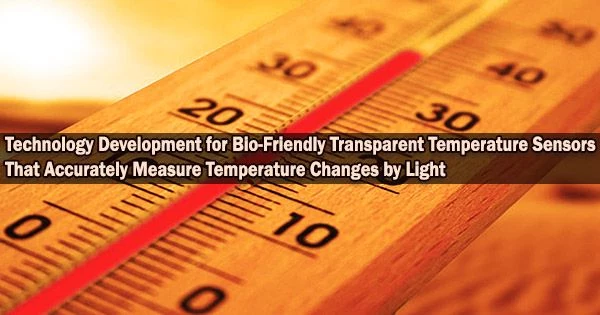The development of a bio-friendly transparent temperature sensor technology would involve the creation of a sensor that can accurately measure temperature changes by using light as the sensing mechanism. This technology would be designed to be non-invasive and biocompatible, making it suitable for use in a variety of biological applications.
Professor Kang Hong-gi of the Department of Electrical Engineering and Computer Science at DGIST(President: Kuk Yang), together with Dr. Chung Seung-jun of the Soft Hybrid Materials Research Center, KIST(President: Yoon Seok-jin) announced the development of a transparent temperature sensor capable of precisely and quickly measuring temperature changes caused by light on Tuesday, December 6, 2022. This technique is anticipated to enhance a number of applied bio gadgets that depend on delicate temperature variations.
Due to its distinctive heating properties utilizing light, the photothermal effect employing plasmonic nanoparticles has lately been widely proposed in numerous bio-application sectors, including brain nerve stimulation, medication delivery, cancer treatment, and ultra-high-speed PCR.
With the limitation that it is not appropriate for local temperature measurement at the level of a single cell, which changes rapidly at the level of several milliseconds to tens of micrometers, photothermal phenomena measurement still relies on an indirect and slow measurement method using a thermal imaging camera.
Despite the widespread use of photothermal effect technology, questions concerning the comprehension of biological changes and stable clinical application resulting from precise temperature changes have been raised due to the lack of exact information on temperature changes.
As a result, the combined research team created a temperature sensor technology that uses the thermoelectric effect, which causes rapid charge transfer to be triggered by a difference in temperature, to record even rapid temperature changes in less than a few milliseconds.
It is significant in that we proposed a technology that directly and precisely measures the photothermal effect, the biggest advantage of which is rapid generation of local heat. We look forward to the possibility of in-depth bioengineering analysis and biomedical application by combining it with various bio-electronic chips through micro-semiconductor processes in the future.
Professor Kang Hong-gi
In particular, the team established a direct photothermal phenomenon measurement technology with reduced interference by light utilizing an organic thermoelectric layer of transparent ‘PEDOT:PSS,’ a conductive polymer suitable for storing charges.
The 50-nanometer thin PEDOT:PSS thermoelectric sensor secures high transparency at 97% on average in the visible light zone and can be directly applied to the area of photothermal phenomenon, minimizing light interference for various photothermal bioengineering and medical applications.
Additionally, the polymer thermoelectric material was prepared using an inkjet printing process, which is easier to manufacture than a general semiconductor process and has a high degree of design freedom, giving it an advantage in the printing process because a low-temperature solution process could be used for the polymer thermoelectric material used.
The optical neural interface for directing brain activity via light, which has lately been well known through optogenetics, can be understood utilizing the transparent thermoelectric temperature sensor technology created through this study. It is a crucial piece of technology because it may be used to examine the fundamentals of using localized high heat to treat cancer cells.
Additionally, based on the idea of powerless operation, it is anticipated that it can be applied to next-generation semiconductor technologies, including transparent display devices, wearable technology, and study of local power semiconductor deterioration.
DGIST Department of Electrical Engineering and Computer Science Professor Kang Hong-gi said, “It is significant in that we proposed a technology that directly and precisely measures the photothermal effect, the biggest advantage of which is rapid generation of local heat,” and added, “We look forward to the possibility of in-depth bioengineering analysis and biomedical application by combining it with various bio-electronic chips through micro-semiconductor processes in the future.”
Additionally, the technology would be designed to be precise, ensuring accurate temperature measurements even in small temperature changes. The development process would likely involve materials science, photonics, and engineering.





